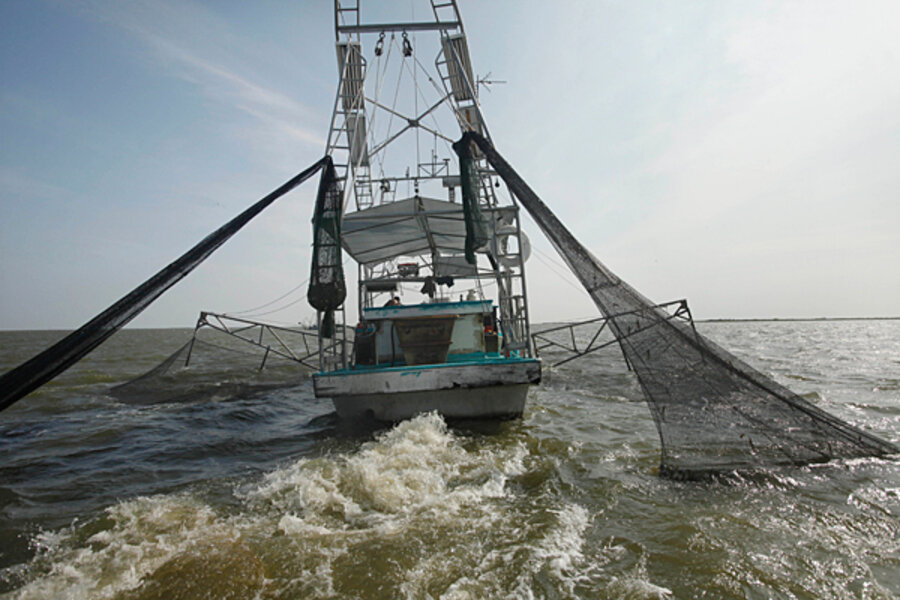What happened to Gulf oil spill? Rosy portrait was hasty, study says.
Loading...
Seventy to 79 percent of the oil that the Deepwater Horizon blowout spewed into the Gulf of Mexico between late April and July 15 was probably still lurking in some form in Gulf waters in early August.
That estimate comes from marine scientists from two institutions affililiated with the Georgia Sea Grant program. It comes two weeks after the unified command (UC) took a first cut at figuring out the oil's fate. The UC report prompted some Obama administration officials to announce that anywhere from half to 75 percent of the Gulf oil spill was gone.
Indeed, natural weathering and biodegradation are slowly taking their toll on remaining oil, notes the team producing the new estimate. And Florida's Keys and East Coast have been spared, thanks to a large ocean eddy spinning in the Gulf and blocking oil from slipping through the Straits of Florida.
Still, the researchers who developed this latest estimate find that "not only is there a lot of oil remaining in the system, but there's a tremendous amount of gas in the system that's not being counted for in the budgeting process," says Samantha Joye, a University of Georgia marine scientist who was a co-author of the report.
The gas she refers to is methane, which accounted for about one-third of the hydrocarbons jetting out of the damaged undersea well.
Even though some officials drew rosy conclusions from the UC report two weeks ago, the data didn't support those conclusions. There were uncertainties surrounding important pieces of information – such as the rates at which microbes were eating oil and the rates at which oil has fallen to the bottom.
Another question mark had to do with the report's lumping of dissolved and evaporated oil into one category. Moreover, researchers have long shown that dispersed and dissolved do not equal "gone," from an ecological perspective.
On one level, the two studies represent a high-profile example of science at work – different teams using different approaches to address the same issue. But when the issue involves the aftermath of the largest offshore oil spill in US history, dueling studies take on enormous political, financial, and even legal implications.
The Sea Grant team started with the UC's total figure for the amount of oil coming from the blowout. Then it discarded the amount that BP captured after it capped the well July 15, since that oil was not affecting anything in the water. This left the group with 4.1 million barrels to account for.
The only category of oil that the Georgia group treated differently was the UC's dissolved/evaporated category, according to Charles Hopkinson, director of the Georgia Sea Grant program and the report's lead author.
The UC analysis team lumped dissolved and evaporated into one category, but it gave no indication of the relative contribution of each. The new study tries to remedy that, estimating that 8 to 12 percent of the total oil spilled is likely to have evaporated as of the Aug. 4 UC report.
The Sea Grant team also tried to estimate the rate at which microbes are eating away at the oil.
No studies have been completed on this topic for the Deepwater Horizon blowout, Dr. Joye says. So the team combed scientific literature, including studies of the Ixtoc 1 blowout in 1979, to anchor its estimate that microbes probably have degraded about 4 to 8 percent of the oil.
The UC study made no similar estimates but merely indicated which of its oil categories would be affected by microbes.
Even as the microbes do their work, however, they leave behind the most toxic of the oil's components, so-called polycyclic aromatic hydrocarbons, the researchers say. Neither estimate takes into account this residual pollutant.
In the end, Dr. Hopkinson acknowledges, both reports are qualitatively saying the same thing: An enormous amount of the blowout's oil remains in the Gulf.
In the next installment, Hopkinson says, it would be helpful to see amounts and their locations estimated, rather than just percentages, along with the confidence placed in the estimated amounts.
Arriving at these kinds of estimates is difficult, given the absence of regular, consistent measurements of oil in its various post-spill forms in the region, he says. The only way to improve future estimates is to develop a rigorous program to monitor oil concentrations monthly in the water, along the seafloor, and along the coastline.
"Then we can actually see how this stuff is mixing and how the concentrations are changing over time to get some estimates of what the rates of degradation are," he says.





